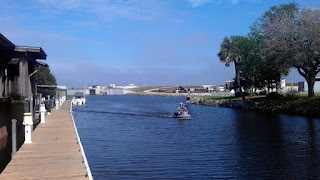“I did not understand, taking those pictures, that history must be collected while the subject exists. If not, what goes unrecorded can fill an ocean.” ~Susanna Daniel, Stiltsville
All too often, people do not take enough time to really delve into what makes their geographic region unique; anywhere a town exists today, there was a historic reason why that town came to be. It could be something as simple as its strategic location along a major transport/trade route; or it could be something related to valuable regional natural resources. And with the growth of any population center, there are always tales of renegades, misfits, and colorful local lore. Here in Miami, we are blessed with many such places…but my absolute favorite is the fascinating elevated waterlocked village of Stiltsville, in Biscayne Bay, just a mile offshore from Key Biscayne.
 |
| A bird's eye view of Stiltsville, in Biscayne Bay. |
This past weekend provided a warm, lazy Sunday that was perfect for taking a cruise down to be among the eclectic array of remains of what was once a booming den of prohibition era nip houses, illegal gambling rings, drug runner drop-offs, and huge parties that long ago catered to the rich and famous, or those of means great enough to gain exclusive membership into the many private clubs that graced the floors of these now-dilapidated structures.
 |
| Picturesque "A-Frame House" with Miami skyline. |
Stiltsville today consists of 7 structures. They sit out on the flats of Biscayne Bay in water that can be as shallow as a few feet at low tide. There are deep finger channels that cut across the flats, making access by boat possible…in fact it is the only option. One of the inaugural buildings of Stiltsville was constructed exactly one mile offshore in the 1930’s, in order to escape the State of Florida’s mile buffer placed on gambling and drinking during prohibition. The maritime village grew to a total of 27 strong at its peak in 1960…however a series of hurricanes kept the stilt house population at bay, as the number of dwellings was always in flux.
 |
| Balwin, Sessions, and Shaw House. |
The National Park Service expanded the boundaries of Biscayne National Park northward to include Stiltsville in 1980. Previously the State of Florida had decided that the stilt buildings could remain, so long as the owners paid an annually renewing lease to the State for use of the submerged land they were occupying. The National Park Service was to honor all existing leases, which in the original terms were renewable until 1999, at which time the structures had to be dismantled at the owner’s expense, and no new construction permits were to be issued. With the destruction deadline looming, and the Park Service unwilling to draft new leases, a desperate effort was made to have Stiltsville listed in the Register of Historic Places, which would grant it amnesty and prevent it from being destroyed. However the application was rejected twice, on the basis that none of the seven remaining structures was at least 50 years old. As a last ditch effort, a petition was started to Save Stiltsville, on the grounds that the location was unique, had local and national historic significance, added to the charm and character of Miami culture, and did not pose any significant negative environmental impacts. After garnering an unprecedented 75,000 signatures, the Park Service amended their management plan to include developing a use for the structures, and allowing the leases to continue until such a time that they could be integrated effectively into Park resources for public use.
 |
| Jimmy Ellenburg House. |
Anyone visiting Stiltsville today is brought back to a simpler time…the dramatic backdrop of the Miami skyline provides a reminder that civilization is near…yet spending an afternoon on the flats, among the houses and abundant pelagic wildlife takes one far, far away from the hustle bustle. If you are lucky, you may find a lower house deck unoccupied, and get the chance to pull your boat up and spend some time on the house (the actual structures themselves, accessible via stairs to the upper wraparound deck, are secured and not open to the public at this time). I have spent quiet afternoons here, snorkeling around the base of the structures’ pilings where sponges, brain and fire corals, and a plethora of tropical fish can be found, as well as lobsters and turtle grasses. A steady stream of large fishing vessels transit the main channel that passes between 4 of the houses. It’s a perfect place to have a BBQ and a cold beer on a hot summer day.
It is my hope that Stiltsville will be indefinitely preserved. It is places such as this that contribute to the character and history of a rapidly-growing city that has a propensity for tearing down old things and building characterless megaplex condos and shopping centers. Stiltsville’s precarious perch on the flats makes it terribly vulnerable to the ravages of hurricanes. Without proper measures and backing, it could be lost forever. So I was more than happy to devote a Sunday afternoon to revisiting a stunning piece of South Florida heritage…South Beach can keep its trendy sidewalk cafes and nightclubs…I’ll see you on the sandbar!
 |
| The two furthest structures are on separate channels. |
(NOTE TO READER: PWC are currently banned in Biscayne National Park, which includes Stiltsville. This renegade PWC’er regularly takes the gamble and goes in anyway; I have been chased out by Fish & Wildlife a few times, but I personally refuse to back down from the biased rule-making No Access crowd. This diatribe will be saved for a later posting that will be devoted in its entirety to the sore subject of selective PWC bans in Public waterways funded by taxpayer dollars, and those heroic souls devoted to wading through the bureaucratic BS to liberate us all from Boating Oppression.)














